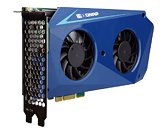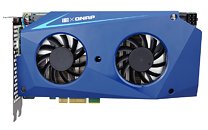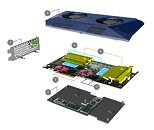Monday, November 19th 2018

QNAP Launches the Mustang-200 Computing Accelerator Card
QNAP Systems, Inc. today launched the Mustang-200 dual-CPU computing accelerator card with 10GbE network connectivity (available with Intel Core i5 / Core i7 / Celeron processors). By installing the card in a compatible QNAP NAS' (or PC's) PCIe slot, users will essentially add two processors to their system for increased computing capabilities to provide a flexible performance boost to their IT infrastructure and applications.
"As QNAP NAS evolves to support a wider range of applications, users need more storage space as well as higher computing capabilities for their NAS system. With the Mustang-200 dual-CPU computing accelerator card, users can instantly boost their system's processing power, which is especially ideal solution for surveillance, virtualization, and AI applications," said David Tsao, Product Manager of QNAP.The innovative QNAP Mustang-200 computing accelerator card (PCIe 2.0 x4) features a dual CPU (including Intel Core i5 / Core i7 / Celeron ) with Intel Graphics. By installing the card in the NAS, users can effectively increase the computing power and transcoding efficiency by the same power as two NAS. Each CPU on the card has a 10GbE network chip with independent IP, allowing users to connect to external networks using any network interface on the host NAS. Users can mount host storage space through iSCSI or VJBOD for the Mustang-200. The Mustang-200's operation environment is also independent from the NAS to prevent performance interference. Users can also install a Mustang-200 in their PC to empower performance-demanding applications (e.g. QVR Pro surveillance application) with greater image processing capability. Models with Intel Core i5 / Core i7 CPUs also have built-in M.2 SSD, providing additional options for faster and smoother application performance.
The Mustang-200 is powered by the intuitive and intelligent mQTS operating system and allows users to enjoy the same range of applications as seen in QTS. Users can install a variety of applications on-demand through the built-in App Center, import other app stores, or perform secondary development on the Mustang-200 to explore further application potential. The Mustang Card Manager assists in centrally managing all of the Mustang-200 (subsystems) installed in the host NAS. Users can monitor system status, configure network and storage resources, and connect to mQTS directly through the Mustang Card Manager for more detailed system configuration and application deployment.
Key specifications of new models
TS-2477XU-RP , TS-1677XU-RP, TS-1685, TS-1677X, TVS-1282, TS-1277, TVS-882, and TS-877.
For more information, visit the product page.
"As QNAP NAS evolves to support a wider range of applications, users need more storage space as well as higher computing capabilities for their NAS system. With the Mustang-200 dual-CPU computing accelerator card, users can instantly boost their system's processing power, which is especially ideal solution for surveillance, virtualization, and AI applications," said David Tsao, Product Manager of QNAP.The innovative QNAP Mustang-200 computing accelerator card (PCIe 2.0 x4) features a dual CPU (including Intel Core i5 / Core i7 / Celeron ) with Intel Graphics. By installing the card in the NAS, users can effectively increase the computing power and transcoding efficiency by the same power as two NAS. Each CPU on the card has a 10GbE network chip with independent IP, allowing users to connect to external networks using any network interface on the host NAS. Users can mount host storage space through iSCSI or VJBOD for the Mustang-200. The Mustang-200's operation environment is also independent from the NAS to prevent performance interference. Users can also install a Mustang-200 in their PC to empower performance-demanding applications (e.g. QVR Pro surveillance application) with greater image processing capability. Models with Intel Core i5 / Core i7 CPUs also have built-in M.2 SSD, providing additional options for faster and smoother application performance.
The Mustang-200 is powered by the intuitive and intelligent mQTS operating system and allows users to enjoy the same range of applications as seen in QTS. Users can install a variety of applications on-demand through the built-in App Center, import other app stores, or perform secondary development on the Mustang-200 to explore further application potential. The Mustang Card Manager assists in centrally managing all of the Mustang-200 (subsystems) installed in the host NAS. Users can monitor system status, configure network and storage resources, and connect to mQTS directly through the Mustang Card Manager for more detailed system configuration and application deployment.
Key specifications of new models
- Mustang-200-i7-1T/32G-R10: Interface: PCIe 2.0 x4, Intel Core i7-7567U CPU 3.5GHz x2, Intel 600P 512GB SSD (per CPU), 16GB (2 x 8GB) DDR4 (per CPU)
- Mustang-200-i5-1T/32G-R10: Interface: PCIe 2.0 x4, Intel Core i5-7267U CPU, 3.1GHz x2, Intel 600P 512GB SSD (per CPU), 16GB (2 x 8GB) DDR4 (per CPU)
- Mustang-200-C-8G-R10: Interface: PCIe 2.0 x4, Intel Celeron 3865U CPU 1.8GHz x2, 4GB (2 x 2GB) DDR4 (per CPU)
TS-2477XU-RP , TS-1677XU-RP, TS-1685, TS-1677X, TVS-1282, TS-1277, TVS-882, and TS-877.
For more information, visit the product page.



18 Comments on QNAP Launches the Mustang-200 Computing Accelerator Card
Only $3,826.32 for the top of the range model...
The cheapest option is $925, but that doesn't come with any SSDs as noted in the new post.
This is based on their Kickstarter campaign with their main company iEi - www.kickstarter.com/projects/1235889177/mustang-200-affordable-scalable-adv-computing-acce
Ugh, the QNAP shop website is really terrible when trying to find a specific product and it's really slow and unresponsive with a ton of damn clicking.
According to Kickstarter info Mustang was scheduled to be released in October 2017.
For this year it should use i7-8559U for example, twice performance in the same wattage and similar price for CPU.
dls.ieiworld.com/IEIWeb/PDC_OBJ/PLM/OWFP000113/Mustang-200_UMN_v1.01.pdf
It seems unlikely to be a drop-in CPU board. Kind of a shame really as that is a very interesting idea for adding CPU power to an existing system.
It was a addon board to transform your S754 motherboard into a S939 one.